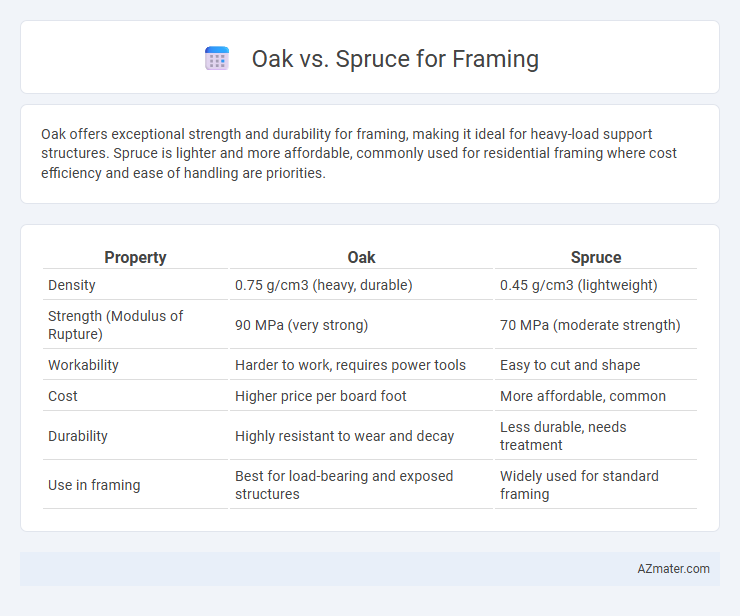Oak offers exceptional strength and durability for framing, making it ideal for heavy-load support structures. Spruce is lighter and more affordable, commonly used for residential framing where cost efficiency and ease of handling are priorities.
Table of Comparison
| Property | Oak | Spruce |
|---|---|---|
| Density | 0.75 g/cm3 (heavy, durable) | 0.45 g/cm3 (lightweight) |
| Strength (Modulus of Rupture) | 90 MPa (very strong) | 70 MPa (moderate strength) |
| Workability | Harder to work, requires power tools | Easy to cut and shape |
| Cost | Higher price per board foot | More affordable, common |
| Durability | Highly resistant to wear and decay | Less durable, needs treatment |
| Use in framing | Best for load-bearing and exposed structures | Widely used for standard framing |
Introduction to Oak and Spruce for Framing
Oak and spruce are commonly used wood species in framing due to their distinct structural properties and availability. Oak offers exceptional strength and durability, making it ideal for load-bearing frames and heavy construction projects where longevity is critical. Spruce provides a lighter, more flexible option with good strength-to-weight ratio, frequently chosen for residential framing and applications requiring easier handling and cost-efficiency.
Wood Strength and Durability Comparison
Oak offers superior wood strength with a high density of 0.75 g/cm3, making it highly resistant to bending and compression loads, ideal for heavy structural framing. Spruce, with a lower density around 0.45 g/cm3, provides moderate strength but excels in flexibility and lightweight characteristics, often preferred for less load-intensive framing. Durability is a key factor; oak's natural tannins resist decay and insect attacks better than spruce, which requires protective treatment for long-term exposure in framing applications.
Weight and Workability Differences
Oak is significantly heavier and denser than spruce, making it more challenging to handle during framing but providing superior strength and durability. Spruce offers excellent workability due to its lighter weight and softer grain, allowing faster cutting and nailing with less effort. Weight differences directly impact labor intensity and structural load, with spruce preferred for ease and speed, while oak is chosen for heavy-duty framing projects requiring robust support.
Resistance to Pests and Decay
Oak exhibits superior resistance to pests and decay compared to spruce due to its dense grain and high tannin content, which act as natural deterrents against insects and fungal growth. Spruce, being a softer wood with a more open grain structure, is more susceptible to termite attacks and moisture-related decay if not properly treated. For framing applications where durability and longevity against biological threats are critical, oak offers a more robust and reliable choice.
Cost and Availability of Oak vs Spruce
Spruce is generally more cost-effective and widely available than oak, making it a preferred choice for framing in budget-conscious construction projects. Oak, while renowned for its strength and durability, commands a higher price due to slower growth rates and limited supply. Availability of oak can be inconsistent, especially in regions where it is less abundant, whereas spruce is commonly harvested and distributed across North America and Europe.
Environmental Impact and Sustainability
Oak and spruce differ significantly in environmental impact and sustainability when used for framing. Oak, a slower-growing hardwood, requires longer harvesting cycles, which may contribute to deforestation if not sourced responsibly, while spruce, a fast-growing softwood, offers more sustainable cultivation with quicker replenishment rates. Spruce's higher carbon sequestration during growth and lower energy demands in processing further enhance its eco-friendly profile compared to oak.
Aesthetic Appeal in Framing Projects
Oak offers a rich, warm grain pattern and a durable surface, making it visually appealing for framing projects that emphasize natural beauty and strength. Spruce features a lighter color and a more uniform texture, lending a clean, minimalist look that complements modern and Scandinavian design aesthetics. Both woods provide distinct aesthetic qualities, with Oak highlighting traditional elegance and Spruce enhancing simplicity and brightness in framed works.
Common Uses in Construction
Oak is valued in construction for its exceptional strength and durability, making it ideal for heavy-duty framing and structural beams in residential and commercial buildings. Spruce, often used in light framing and sheathing, provides a cost-effective, lightweight option with good workability for walls, roofs, and interior supports. Both woods are common in construction, with oak favored for load-bearing applications and spruce preferred for general framing where weight and ease of handling are priorities.
Maintenance and Longevity
Oak offers superior durability and resistance to decay compared to spruce, making it a low-maintenance choice for framing with a longer lifespan often exceeding several decades. Spruce, while more affordable and easier to work with, requires regular treatments against moisture and pests to prevent rot and degradation over time. Properly maintained oak frames can withstand harsh environmental conditions with minimal repairs, whereas spruce frames might need frequent inspections and upkeep to ensure structural integrity.
Choosing the Right Wood for Your Framing Needs
Oak offers exceptional strength and durability, making it ideal for framing projects that require long-lasting structural support. Spruce is commonly used in framing due to its lightweight nature, ease of handling, and cost-effectiveness, while still providing sufficient strength for most residential construction. Selecting the right wood depends on whether the priority is heavy load-bearing capacity, where oak excels, or affordability and ease of installation, where spruce is preferred.

Infographic: Oak vs Spruce for Framing
 azmater.com
azmater.com